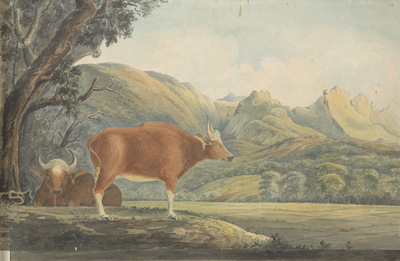Javascript must be enabled to continue!
f.11 Wild buffalo
View through Europeana Collections
Water-colour drawing by John Johnson of a water
buffalo taken from a sketch-book of 36 drawings (36 folios)
depicting scenes chiefly in W. India and Mysore, dated
c.1795-1801.The wild water buffalo is the ancestor of the domestic
water buffalo, which is now found in most tropical and subtropical
regions. It originally ranged from eastern Nepal and India, east to
Vietnam, and south to Malaysia. The interbreeding with domestic
buffalo, the loss of habitat due to cultivation, large-scale
poaching and communal hunting have drastically reduced the wild
buffalo population which is now under severe threat. The wild water
or Asian buffalo is a massive and powerful animal. It is dark brown
in color, with short, sparse hair and has broad, flat, notched
horns. It is found in wet grasslands and marshes, near pools and
near large rivers. These animals are very dependent on the
availability of water and are primarily grazers and, when not
feeding, spend the majority of their day bathing and
wallowing.
Title: f.11 Wild buffalo
Description:
Water-colour drawing by John Johnson of a water
buffalo taken from a sketch-book of 36 drawings (36 folios)
depicting scenes chiefly in W.
India and Mysore, dated
c.
1795-1801.
The wild water buffalo is the ancestor of the domestic
water buffalo, which is now found in most tropical and subtropical
regions.
It originally ranged from eastern Nepal and India, east to
Vietnam, and south to Malaysia.
The interbreeding with domestic
buffalo, the loss of habitat due to cultivation, large-scale
poaching and communal hunting have drastically reduced the wild
buffalo population which is now under severe threat.
The wild water
or Asian buffalo is a massive and powerful animal.
It is dark brown
in color, with short, sparse hair and has broad, flat, notched
horns.
It is found in wet grasslands and marshes, near pools and
near large rivers.
These animals are very dependent on the
availability of water and are primarily grazers and, when not
feeding, spend the majority of their day bathing and
wallowing.
Related Results
Fragment of a terracotta oinochoe (jug)
Fragment of a terracotta oinochoe (jug)
Terracotta, Archaic, East Greek Wild Goat Style...
Fragment of a terracotta stemmed dish
Fragment of a terracotta stemmed dish
Terracotta, Archaic, East Greek Wild Goat Style...
Fragment of a terracotta oinochoe (jug)
Fragment of a terracotta oinochoe (jug)
Terracotta, Archaic, East Greek Wild Goat Style...
Fragment of a terracotta plate
Fragment of a terracotta plate
Terracotta, Archaic, East Greek Wild Goat Style...
Recent Results
Chinese Ti-Tzu, So-na, Yueh-ch'in, Japanese Hiji-riki and Chinese La-pa
Chinese Ti-Tzu, So-na, Yueh-ch'in, Japanese Hiji-riki and Chinese La-pa
The Ti-Tzu (left) is a Chinese flute and is traditionally bound with waxed silk and decorated with tassels. The So-na is a copper wind instrument - a kind of oboe - played with a d...
Chinese jades in the Avery Brundage Collection
Chinese jades in the Avery Brundage Collection
René Yvon Lefebvre d'Argencé, Chinese Art objects, 1972, Published by the de Young Museum Society and Patrons of Art and Music for the Center of Asian Art and Culture...




